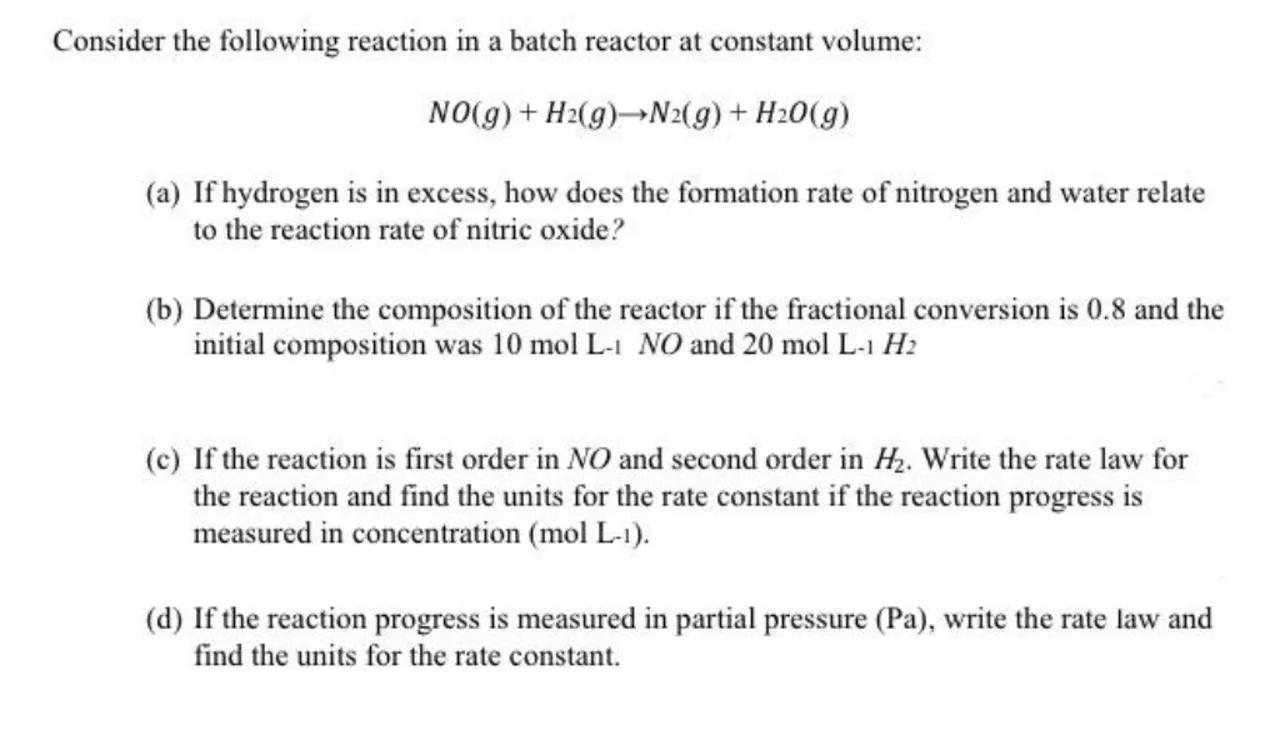
Sia
Consider the following reaction in a batch reactor at constant volume:
(a) If hydrogen is in excess, how does the formation rate of nitrogen and water relate to the reaction rate of nitric oxide?
(b) Determine the composition of the reactor if the fractional conversion is 0.8 and the initial composition was and
(c) If the reaction is first order in and second order in . Write the rate law for the reaction and find the units for the rate constant if the reaction progress is measured in concentration ( .
(d) If the reaction progress is measured in partial pressure , write the rate law and find the units for the rate constant.

Answer from Sia
Posted over 1 year ago
Solution
1
Stoichiometry of the reaction: The balanced chemical equation is . This indicates that 2 moles of NO react with 2 moles of H₂ to form 1 mole of N₂ and 2 moles of H₂O
2
Relation of formation rates: Since hydrogen is in excess, it does not limit the reaction rate. The formation rate of N₂ and H₂O is directly related to the consumption rate of NO by the stoichiometry of the reaction
a Answer
The formation rate of N₂ and H₂O is half the reaction rate of NO when H₂ is in excess.
Key Concept
Stoichiometry and reaction rates
Explanation
The formation rates of products in a chemical reaction are directly related to the consumption rates of reactants according to the stoichiometry of the balanced chemical equation.
1
Initial moles of NO and H₂: Initially, there are of NO and of H₂
2
Moles of NO reacted: With a fractional conversion of 0.8, of NO have reacted
3
Moles of NO remaining: of NO remain
4
Moles of H₂ remaining: Since H₂ is in excess and the stoichiometry is 1:1, we assume there is still excess H₂ left
5
Moles of N₂ formed: of NO reacted to form of N₂
6
Moles of H₂O formed: Similarly, of NO reacted to form of H₂O
b Answer
After a fractional conversion of 0.8, the composition is NO, excess H₂, N₂, and H₂O.
Key Concept
Fractional conversion and stoichiometry
Explanation
The composition of the reactor after a certain fractional conversion can be determined by using the initial amounts of reactants and the stoichiometry of the balanced chemical equation.
1
Rate law expression: The rate law for the reaction, given it is first order in NO and second order in H₂, is
2
Units for rate constant: The overall order of the reaction is . The units of the rate constant are for a third-order reaction when concentration is used
c Answer
The rate law is with units for being .
Key Concept
Rate law and reaction order
Explanation
The rate law expresses the rate of a chemical reaction in terms of the concentration of reactants and the rate constant, whose units depend on the overall reaction order.
1
Rate law with partial pressures: The rate law, when expressed in terms of partial pressures, is
2
Units for rate constant with partial pressures: The units for the rate constant when using partial pressures are for a third-order reaction
d Answer
The rate law is with units for being .
Key Concept
Rate law with partial pressures
Explanation
The rate law can also be expressed in terms of partial pressures, and the units of the rate constant will change accordingly to reflect the different units of measurement.
Not the question you are looking for? Ask here!
Enter question by text
Enter question by image
Unlock Smarter Learning with AskSia Super!
Join Super, our all-in-one AI solution that can greatly improve your learning efficiency.
30% higher accuracy than GPT-4o
Entire learning journey support
The most student-friendly features
Study Other Question